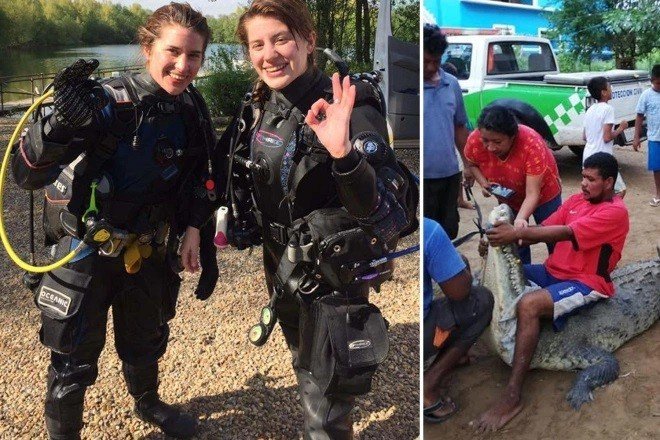A BRITISH zookeeper who was nearly killed in a crocodile attack in Mexico has urged authorities to protect the reptiles, saying: “It’s not the crocodiles’ fault.”
Now out of a coma and newly released from hospital, Melissa Laurie, 28, wishes to prevent another ordeal like she and her twin Georgia have just been through, which left her intubated and fighting for her life.
She wants to appeal to the Mexican government to protect the crocodiles, after authorities discussed proposals to deal with them – including culling the creatures.
Melissa, in a lengthy conversation from Puerto Escondido, said: “Just because a traumatic event like this has happened it doesn’t leave me wishing that the crocodiles pay the price.
“Crocodiles are the ultimate survivors. They are fascinating creatures. They’re nearly 200 million years old as a species. Essentially they’re living dinosaurs.
“I am extremely upset and angry by the proposal to cull the crocodile population. Why shoot them with guns when we could shoot them with cameras instead?”

The horrific Sunday afternoon attack, on June 6, left Melissa in a medically induced coma, with water-filled lungs, and abdominal wounds that penetrated her stomach and gut, which led to sepsis.
It was the quick thinking of her twin sister Georgia, a certified divemaster, who saved her from the 10-foot croc by repeatedly “bashing it on the nose” as it tried to drag Melissa underwater.
Georgia was lucky to be left with only lacerations on her hand and bite marks up her wrist, later describing how she had to “drag her by the hair”.
She managed to pull Melissa’s nearly lifeless body out of the water.
Though born just ten minutes apart, Melissa said Georgia still lets her know that she is the eldest of the inseparable pair.
She said: “It’s Georgia’s search and rescue training that came into play.”
Looking back on the incident, and the roles each twin was forced into, Melissa said: “Life takes you in a direction that you just don’t expect sometimes.
“I would hope it’s anyone’s instinct to think to do the same when it comes to fighting off a crocodile. You punch predators in the face.”
Melissa and Georgia both insist that if they had seen a sign warning of the presence of crocodiles, they would have known better than to enter the water in the stream leading to the Manialtepec lagoon, about 12 miles outside of Puerto Escondido.
But they did not see a sign.
The lagoon features stunning blue bioluminescent waters in the evening – the main attraction that led to the nearly fatal encounter, during which Melissa was repeatedly lunged at by the giant reptile, which clamped onto her body on three separate occasions.
Local licensed tour guides would have known to warn them of the presence of crocodiles as this area is the scene of frequent sightings.
But the unregulated tour they ended up on – onboard the Espatula Rosada boat – had been arranged by a man operating as an illegal guide.
The twins, from Sandhurst, Berks., knew him only as ‘Richie’.
He repeatedly assured them that the waters were safe to swim in, despite being a known nesting place where crocodiles care for their young during the rainy season.
The rogue tour guide has now fled.

One local authority told The Sun that it would be looking to “make an example of” the boat owner and boatmen who participated in the tour.
The underage boathand, Moises Salinas, who is just 16-years-old, was instrumental in getting Melissa to the hospital in time to save her life.
Melissa now fears that “local Mexicans will be made to suffer” for the attack.
She said: “It’s how they put food on the table. It isn’t fair.”
Melissa and Georgia have been reluctant to place the blame for the life-altering attack on anyone in particular.
Now Melissa is on her road to recovery and no longer fears for her own life, which she very nearly lost as her lungs filled with water and infection set in, she is hoping that crocodiles, too, will be spared.
She said: “Wildlife conservation is extremely important to me.”
Melissa, a former hoofstock keeper, worked with giraffes, zebras, white rhino, and elephants at the Longleat Safari Park in Wiltshire – the first drive-through safari park outside of Africa.
She has held many jobs and volunteer positions with animals over the years.
Melissa said: “I have experience looking after and working with reptiles – snakes and bearded dragons and amphibians.”
Despite nearly taking her life, she still speaks with awe about crocodiles.
She said that she had seen another crocodile swimming around months ago in Cancun, as she floated in a pool overlooking a lagoon on the Riviera Maya.
Melissa said: “I thought ‘Wow! This is amazing’.”
That lagoon, she said, had proper signage telling guests not to swim because of the crocs.
But on the day of the attack, she never reached the centre of the lagoon, where swimming is allowed, and did not get to see the glowing bioluminescent plankton.
Had she, she would have seen how these tours are conducted.
When guides take groups of tourists out at night, they first create a perimeter by going in circles in the water, hoping the revving boat motors will scare off any crocs.
Then, while tourists bathe in the glowing water, boathands stay onboard shining flashlights, trolling for a glimpse of the crocs’ eyes glimmering in the distance.
Melissa said: “If I knew the bioluminescence tour is carried out in a way which I think disturbs the wildlife like that, I wouldn’t have gone.
“Just seeing the wildlife and the birds would have been enough.
“We don’t know what sort of problems we are actually causing on an eco-level by disturbing their waters.
“And it sounds dangerous, actually. There are safer ways to see the bioluminescence in Mexico than encroaching on their habitat — again, at night. That’s when they do a lot of their hunting.”

The crocs, she said, deserve the right to nest in peace, “enjoying their full habitat” and undisturbed by loud motors and gawking tourists.
Melissa thinks that if the authorities must decide between catering to tourists or protecting local wildlife, the animals must come first.
A representative for the Puerto Escondido Secretary of Tourism, Julian Herrera, accompanied Georgia and the twins’ parents on a tour of the scene of the attack last week.
He told The Sun that the local authorities will be studying the risks to tourists at the site.
He added: “If there is even a two percent risk that this could happen again, we will have to prohibit swimming in the lagoon.”
Melissa feels that this is the best solution, “for the crocodiles and nature”.
She added: “It would benefit the whole ecosystem if humans aren’t trampling through it as much.”
Melissa would also like to see their known nesting areas preserved and kept off limits, both for the safety of the people and the protection of the creatures and their offspring.
There are places to swim in and see the bioluminescent phenomena in Mexico “in a safe way” she said, as she did just months ago while travelling through Mexico.
She added: “It’s amazing. It’s like the universe, but in the water.”
Melissa is by no means the first croc attack victim near Puerto Escondido.
The Animal Management graduate is just one of at least 39 victims of crocodile attacks along the Oaxacan coast since 2004.
Local researcher and wildlife expert at the Universidad del Mar, in Mexico, Jesus Garcia Grajales, has spent years studying and compiling data on crocodile attacks in the region.
He has counted six fatal encounters, but said “that is likely an underestimate” as many minor incidents which do not require medical intervention often go unreported.
He said: “There have been drastic cases of even children under the age of three, resulting in death.”
Of the six people who have been killed by crocodiles during this period, four were children under the age of ten.
Roughly a third of the victims have been children. Several others have had limbs amputated by the crocs’ powerfully clenched jaws.
Melissa, too, came close to losing her left leg, as the crocodile latched on, twisting her violently in a death roll.
Puerto Escondido relies on tourism and an influx of foreign cash and local officials are now seeking a solution that will ensure tourists continue to visit and feel safe.
Researcher Garcia Grajales knows that often when crocodiles attack, the backlash against them can be brutal and “the death of an unquantified number of crocodiles ensues”.
In years past, the solutions discussed have typically amounted to “adding signs to raise awareness of the crocodile’s presence”.
But in the face of mounting media attention, some local authorities are now floating a more radical solution – a culling or eradication program to limit the crocodile population.
The Sun was granted exclusive access to a closed-door emergency meeting last week between more than 30 local officials.
‘PROTECTED SPECIES’
They complained that each week they are called out to deal with giant boas and four-metre-long crocodiles wandering around near homes and restaurants or eating people’s animals.
Just last month, one social media user tweeted in Spanish, “an enormous crocodile ate my daughter’s dog in one bite,” adding that the local authorities “MUST URGENTLY PROTECT HUMANS AS WELL,” followed by the hashtag #BewareOfTheCrocodiles.
Local public security head Guillermo Silva said during the meeting: “Every day there are more of them, and we have to go out and spend time responding to these calls.”
While promoting the idea of controlled eradication, he said “similar programs have worked in Florida”.
But Diana Gonzalez Garcia, the head of sustainability and environmental policy for nearby San Pedro Pochutla, who attended the meeting, told The Sun that crocodiles must be protected.
She said: “The crocodiles are a protected species. The answer should not be population control, to the contrary, it is we who are the invaders, encroaching on their habitat.
“Us biologists will not be in favor of that, and we will not allow it. We need to train and educate our public servants on proper wildlife management.”
Up until very recently, she said, when responding to complaints about serpents, the authorities would come “chop off their heads with a machete.”
She claimed that the crocodiles “are handled very roughly by those without the proper training.”
Preserving the swarms of foreign tourists seen walking barefoot through the streets of Oaxacan beach towns is certainly a priority for the local government.
But Melissa agrees with conservationists that it is “humans who are encroaching” on crocodile’s habitat and not the other way around.
She added: “I think Mexico should be using the crocodiles as an opportunity for ecotourism. It could really draw people into the area.”
Melissa insisted that if she had seen a sign warning of the presence of crocodiles, or even just “a picture of a crocodile” they would not have entered the water.
In response to the attack, local authorities from the local department of public safety rushed to place new signs on trees surrounding the lagoons, in English and Spanish.
They warn “danger, crocodile area”.
Melissa added: “That is a good first step.”
sunit




